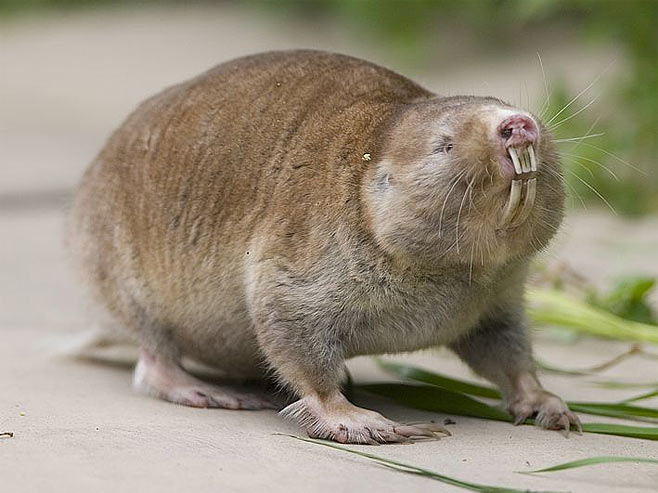|
Bathyergus suillus (Cape dune mole-rat)
Cape dune blesmol [English]; Kaapse duinmol [Afrikaans]; Kap-Strandgräber
[German]; fouisseur [French]
Life
>
Eukaryotes >
Opisthokonta >
Metazoa (animals) > Bilateria > Deuterostomia >
Chordata > Craniata > Vertebrata (vertebrates) >
Gnathostomata (jawed vertebrates) > Teleostomi (teleost
fish) > Osteichthyes (bony fish) > Class:
Sarcopterygii (lobe-finned fish) > Stegocephalia
(terrestrial vertebrates) > Reptiliomorpha > Amniota >
Synapsida (mammal-like reptiles) > Therapsida > Theriodontia
> Cynodontia > Mammalia (mammals)
> Placentalia (placental mammals) >
Euarchontaglires > Glires > Rodentia (rodents) > Hystricognathi
> Bathyergidae (mole-rats)
 |
|
Bathyergus suillus (Cape dune mole-rat),
Rondevlei Nature Reserve, Cape Town, South Africa. [photo Trevor
Hardaker ©] |
Identification
The Cape Dune mole-rat is the largest completely
subterranean mammal in Africa. The body is cylindrical covered in short thick
fur, with short limbs and a tail. There is a stiff fringe of hair on the tail
and on the outside edge of the hindfeet, this helps to control the soil while
digging. Adapted for digging, the eyes are small and there are no
external ear pinnae. The nose is flat, with tough bare skin and valvular
nostrils. One of the mole-rats most characteristic features are the large white
protruding incisors. The lips close behind the grooved teeth, this stops the
mole-rate from swallowing sand while digging or feeding. The feet have strong
claws for digging.
Size
Body length 250 – 350 mm; weight range 1 –2.5 kg
Distribution and habitat
Soft coastal sands of the Western Cape, especially coastal
strandveld.
General behaviour
Dune mole rats are solitary and aggressively territorial,
each animal maintaining its own burrow system that is spaced apart from its
neighbour. The animals rarely venture above ground, but are often forced above
ground during the rainy season when the water table rises.
Food
They eat bulbs, tubers, leaves and stems of plants.
Predators, parasites and commensals
Their predators include snakes, eagles, jackals and
Caracal.
Gestation period
93 - 94 days
Life span
12-15 years
Conservation
Dune moles are economic pests. They undermine roads
and runways and chew through subterranean cables and irrigation systems. They
eat plants and their large mounds can cause damage to harvesting machinery.
|
